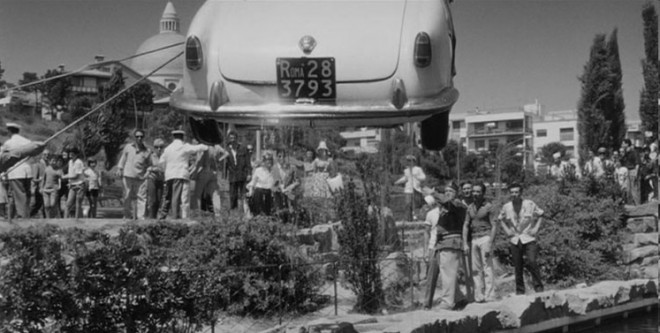Responding to former-Allied reaction to the swift postwar Communist takeover of other east European countries, including Poland and Czechoslovakia, Soviet leader Stalin pressed for a “gradualist” approach in Hungary relying on leftist coalitions, including the nation’s Communist Party, in Hungarian elections. At the same time, the Soviet Union controlled the Hungarian police. Fényes szelek, alternatively called in English Sparkling Winds and The Confrontation, dramatizes a clash between two Hungarian student groups in 1947, one Marxist and the other, more modestly, advocating reform.
Miklós Jancsó’s fine film, which reflects student activism in the direction of freedom in its own time, finds the revolutionary group attempting to persuade the others to their side. A young police officer, whose contradictory behavior may be either calculated or ambivalently heartfelt, also participates in the scene.
The setting is the grounds of the Catholic school which the more conservative students attend. A brilliant image encapsulates the sacred mystery that the student “confrontation” threatens to encroach upon. An outside doorway appears to disclose an eternity of darkness; then a row of nuns turn part-way, revealing that the “darkness” had been the black backs of their habits. When they turn back around, the “darkness” returns, except now that we know what is there we strain to detect the habits: ours, an act of demystification. We have been perceptually radicalized; we are thereby implicated in what we had been watching, we thought, at a safe remove.
This is Jancsó’s first film in color—muted, dusky color punctuated by the vivid red of a boy’s shirt and of a streaming banner, with its suggestion of Hungarian bloodshed; it is also the first film by Jancsó to rely so heavily on what has become part of his artistic signature: Hungarian folk singing and dance. Here their use can be ambiguous, suggesting a common bond of culture and history among Hungarians, but also showing their calculated use to insist on this bond while downplaying, even hiding, profound political differences. Relatedly, hand-in-hand circular human chains image forth both instances of inclusion and exclusion, liberation and noose-like restriction, confinement, imprisonment. Fluid, exceptionally long takes are similarly ambiguous: the mere illusion of breadth and freedom.
However, Fényes szelek is not one of Jancsó’s masterpieces. Indeed, at times it resembles a dry run for his glorious Red Psalm (1972).
B(U)Y THE BOOK
MY BOOK, A Short Chronology of World Cinema, IS CURRENTLY AVAILABLE FROM THE SANDS FILMS CINEMA CLUB IN LONDON. USING EITHER OF THE LINKS BELOW, ACCESS THE ADVERTISEMENT FOR THIS BOOK, FROM WHICH YOU CAN ORDER ONE OR MORE COPIES OF IT. THANKS.
